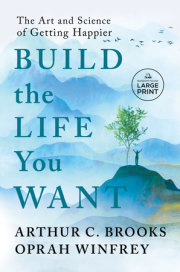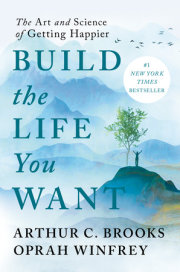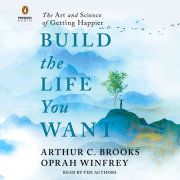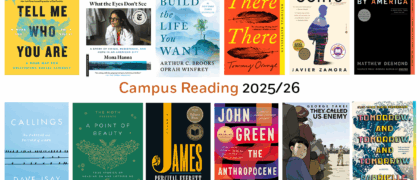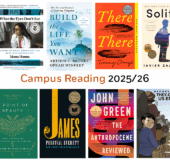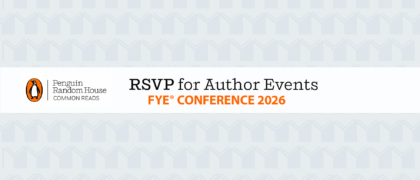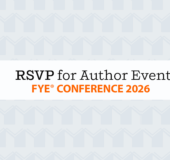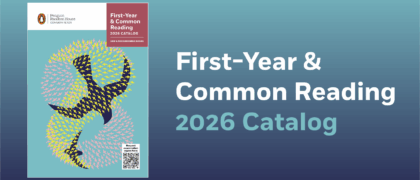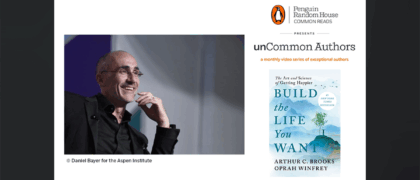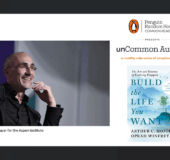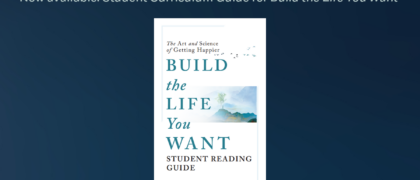A Note from Oprah
One of the many things I got from doing
The Oprah Winfrey Show for twenty-five years was a front-row seat to unhappiness. Of every, and I mean every, kind. My guests included people devastated by tragedy, or betrayal, or deep disappointment. Angry people and people who held grudges. People full of regret and guilt, shame and fear. People doing everything in their power to numb their unhappiness but waking up each day unhappy anyway.
I also witnessed abundant happiness. People who had found love and friendship. People using their talents and abilities to do good things. People who reaped the rewards of selflessness and giving, including one person who’d even donated a kidney to a stranger he’d recently met. People with a spiritual side that brought richer meaning to their lives. People who’d been given a second chance.
Where the audience was concerned, the unhappy guests generally provoked empathy; the happy ones, admiration (and maybe a twinge of wistful envy). And then there was a third category of guest that audiences didn’t know
what to make of but were genuinely inspired by: people who had every reason to be unhappy and yet were not. The lemonade-making, silver-linings-finding, bright- side-looking glass-half-fullers. The Mattie Stepaneks, is how I came to think of them—Mattie Stepanek being the boy who had a rare and fatal form of muscular dystrophy called dysautonomic mito- chondrial myopathy, yet managed to find peace in all things and play after every storm. He wrote lovely poetry, was wise beyond his years, and was the first guest I ever befriended beyond the show. I used to call him my angel guy.
How could a boy with a fatal disease be as happy as Mattie was? Same with the mother who was full of peace and purpose and ac- tual joy even as she was preparing to die, recording hundreds of voice tapes for her then-six-year-old daughter about how to live. And the Zimbabwean woman who was married at age eleven, beaten daily, yet instead of giving in to despair, maintained hope, set secret goals, and eventually achieved them—including earning a PhD.
How could these people even get out of bed in the morning, let alone be such rays of light? How did they do it? Were they born that way? Was there a secret or pattern of development the rest of the world should know? Because trust me, if there
was such a thing, the world would definitely want to know. In my twenty-five years of doing the show, if there was one thing almost everyone in every audience had in common, it was the desire to be happy. As I’ve said before, after every show I’d chat with the audience, and I al- ways asked what they most wanted in life. To be happy, they’d say. Just to be happy. Just happiness.
Except, as I’ve also said before, when I asked what happiness was, people suddenly weren’t sure. They’d hem and haw and finally say “losing X number of pounds” or “having enough money to pay my bills” or “my kids—I just want my kids to be happy.” So they had
goals, or
wishes, but they couldn’t articulate what happiness looked like. Seldom did anyone have a real answer.
This book has the answer, because Arthur Brooks has studied and researched and lived the answer.
I first came across Arthur through his column in
The Atlantic,
“How to Build a Life.” I started reading it during the pandemic and it quickly became something I looked forward to every week because it was all about what I’ve always cared most about: living a life with purpose and meaning. Then I read his book
From Strength to Strength, a remarkable guide to becoming happier as you age. This man was singing my song.
Clearly, I had to talk to him. And when I did, I instantly realized that if I’d still been doing
The Oprah Winfrey Show, I would have been calling on him all the time—he would have had some- thing relevant and revealing to contribute to almost every topic we discussed. Arthur exudes a kind of confidence and certainty about the meaning of happiness that’s both comforting and galvanizing. He’s able to talk both broadly and very specifically about the very same things I’ve been talking about for years: how to grow into your best self, how to become a better human being. So I knew from the start that I would somehow end up working with him. That some- how is this book.
A Note from Arthur
You must naturally be a very happy person.”
I hear this all the time. It makes sense, after all: I teach courses on happiness at Harvard University. I write a regular hap- piness column for
The Atlantic. I speak about the science of happi- ness all around the world. So, people assume, I must have natural gifts for happiness, like a professional basketball player must be a naturally gifted athlete. Lucky me, right?
But happiness isn’t like basketball. You don’t have a leg up on becoming a happiness specialist by being blessed with natural well-being. On the contrary, naturally happy people almost never study happiness, because to them, it doesn’t seem like something one needs to study, or even think much about. It would be like studying air.
The truth is that I write, speak, and teach about happiness pre- cisely because it’s naturally hard for me, and I want more of it. My baseline well-being level—the level where I would sit if I didn’t study it and work on it every day—is significantly lower than av- erage. It’s not as if I have had huge trauma or unusual suffering. No one should feel sorry for me. It just runs in the family: my grand- father was gloomy; my father was anxious; left to my own devices, I am gloomy and anxious. Just ask my wife of thirty-two years, Ester. (She’s nodding
yes as she reads this.) So my work as a social scientist isn’t research—it’s
me-search.
If you are coming to this book because you are not as happy as you want to be—whether because you are suffering from some- thing in particular, or you have a good life “on paper” but always find yourself struggling—you are the kind of person I relate to best. We are kindred spirits.
When I started studying happiness twenty-five years ago as a PhD student, I didn’t know if academic knowledge would help. I feared that happiness wasn’t something you could change in a mean- ingful way. Maybe it was like astronomy, I thought. You can learn about the stars, but you can’t change them. And in fact, for a long time, my knowledge didn’t help me very much. I knew a lot, but it wasn’t practical in any way. It was just observations about who the happiest people were—and the unhappiest.
A decade ago during a particularly dark and stormy time in my life, Ester asked a question that changed my thinking. “Why don’t you use all that complicated research to see if there are ways you can change your own habits?” Obvious, right? For some reason, it wasn’t obvious to me at all, but I was willing to try. I started spend- ing more time observing my well-being levels to pick out patterns. I studied the nature of my suffering and the benefits I likely derived
from it. I set up a series of experiments based on the data, trying things like making a gratitude list, praying more, and pursuing the opposite behavior of my inclination when I was sad and angry (which was pretty often).
And I saw results. As a matter of fact, it worked so well that in my spare time from my job running a large nonprofit organiza- tion, I started writing about happiness and real-life applications in
The New York Times to share them with others. People began to get in touch to say the science of happiness—translated into prac- tical advice—was helping them, too. And I found that teaching ideas in this way solidified the knowledge in my mind and made me even happier.
Obviously, I wanted more. So I changed careers. At the age of fifty-five, I quit my chief executive job, with a plan to write, speak, and teach about the science of happiness. I started by creating a simple personal mission statement for myself. I dedicate my work to lifting people up and bringing them together, in bonds of love and happiness, using science and ideas.
I accepted a professorship at Harvard University and created a class on the science of happiness, which quickly became over- subscribed. Then I started a regular column on the subject at
The Atlantic that found a readership of hundreds of thousands a week. I investigated a new happiness topic every week by using my back- ground as a quantitative researcher to read the cutting-edge psy- chology, neuroscience, economics, and philosophy. Then I turned the learnings into real-life experiments on myself. When it worked, I would teach my students what I learned, and publish it publicly for a mass audience.
As the years turned over, I saw more and more progress in my life. I observed how my brain was processing negative emotions and learned how to manage these emotions without trying to get rid of them. I began to see relationships as an interplay between hearts and brains, and not some inscrutable mystery. I started adopting the habits of the happiest people that I saw in the data, and whom I knew in my real life (including someone very special, whom you will meet in the Introduction that comes next). At the same time, I began to hear from people all around the world—some I had never heard of, others very famous—who were learning with me that they could raise their own happiness levels if they did the work to learn and apply their knowledge.
In the years since I made this life change, my own well-being has risen
a lot. People notice and remark that I smile more, and I look like I’m having more fun in my work. My relationships are better than they were. And I have seen improvements like this in students, business leaders, and ordinary people who learn the prin- ciples. Many of them have experienced pain and loss beyond any- thing I have ever faced, and found joy even amid their suffering.
I still have plenty of bad days, and I have a long way to go, but today I am comfortable with my bad days, and I know how to grow from them. I know rough times will come, but I’m not afraid of them. And I am confident that there is a lot of progress in my future.
Sometimes I think back to myself at thirty-five or forty-five years old, when I was so rarely joyful and looked to the future with a sense of resignation. If fifty-nine-year-old me went back in time and said, “You are going to learn to be happier, and teach the se- crets to others,” I probably would have said that future me had gone insane. But it’s true (the getting happier part—not the going in- sane part).
And now I am privileged to team up in my work with some- one I have admired since I was a young man—a person who her- self has lifted up millions of people in bonds of love and happiness all over the world: Oprah Winfrey. When we first met, we quickly realized that we shared a mission, even though we pursued it in different ways—I in academia, and Oprah in mass media.
Our mission in this book is to tie together the two strands of our work, to open up the amazing science of happiness to people in all walks of life, who can use it to live better and lift up others. In plain language, we seek to help you see that you are not help- less against the tides of life, but that with a greater understanding of how your mind and brain work, you can build the life you want, starting inside with your emotions, and then turning outward to your family, friendships, work, and spiritual life.
It worked for us, and it can work for you, too.
Copyright © 2023 by Arthur C. Brooks and Oprah Winfrey. All rights reserved. No part of this excerpt may be reproduced or reprinted without permission in writing from the publisher.



